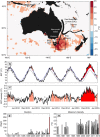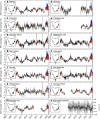The unprecedented 2015/16 Tasman Sea marine heatwave
- PMID: 28706247
- PMCID: PMC5519980
- DOI: 10.1038/ncomms16101
The unprecedented 2015/16 Tasman Sea marine heatwave
Abstract
The Tasman Sea off southeast Australia exhibited its longest and most intense marine heatwave ever recorded in 2015/16. Here we report on several inter-related aspects of this event: observed characteristics, physical drivers, ecological impacts and the role of climate change. This marine heatwave lasted for 251 days reaching a maximum intensity of 2.9 °C above climatology. The anomalous warming is dominated by anomalous convergence of heat linked to the southward flowing East Australian Current. Ecosystem impacts range from new disease outbreaks in farmed shellfish, mortality of wild molluscs and out-of-range species observations. Global climate models indicate it is very likely to be that the occurrence of an extreme warming event of this duration or intensity in this region is respectively ≥330 times and ≥6.8 times as likely to be due to the influence of anthropogenic climate change. Climate projections indicate that event likelihoods will increase in the future, due to increasing anthropogenic influences.
Conflict of interest statement
The authors declare no competing financial interests.
Figures







References
-
- Lima F. P. & Wethey D. S. Three decades of high-resolution coastal sea surface temperatures reveal more than warming. Nat. Commun. 3, 704 (2012). - PubMed
-
- Hobday A. et al.. A hierarchical approach to defining marine heatwaves. Prog. Oceanogr. 141, 227–238 (2016).
-
- Olita A., Sorgente R., Ribotti A., Natale S. & Gaberšek S. Effects of the 2003 European heatwave on the Central Mediterranean Sea surface layer: a numerical simulation. Ocean Sci. Discuss. 3, 85–125 (2006).
-
- Sparnocchia S., Schiano M. E., Picco P., Bozzano R. & Cappelletti A. The anomalous warming of summer 2003 in the surface layer of the Central Ligurian Sea (Western Mediterranean). Ann. Geophys. 24, 443–452 (2006).
-
- Benthuysen J., Feng M. & Zhong L. Spatial patterns of warming off Western Australia during the 2011 Ningaloo Niño: quantifying impacts of remote and local forcing. Cont. Shelf Res. 91, 232–246 (2014).
Publication types
LinkOut - more resources
Full Text Sources
Other Literature Sources

